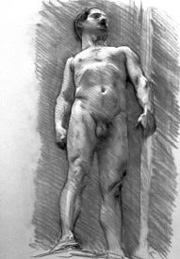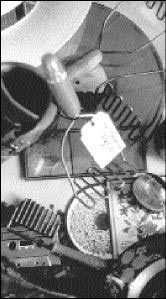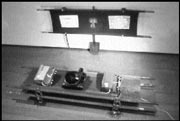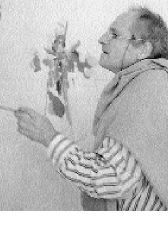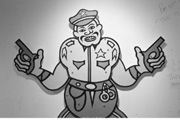ANDY WARHOL ONCE got a personal tour of John Singer Sargent portraits from Trevor Fairbrother. In the 1980s, the man who would become Seattle Art Museum’s curator for modern art and one of the country’s leading Sargent scholars led Andy through the Whitney Museum of Art, as if to point out the surprising similarities between two artists so utterly separated by time, place, and aesthetic sensibilities: one, a stiff Victorian portraitist; the other, a hedonist breaking new ground in conceptual art. Both were rather reserved—awkward, even—as they were caught up and embraced by an intense social whirl. Both were drawn to glamour, drama, costume, and rich adornments. By extreme talent, in Sargent’s case, and by sheer brilliance and incessant quirkiness in Warhol’s, both men gained status among the celebrities of their respective days and came to be emblems themselves of a certain lifestyle and social milieu. Almost two decades after Andy got the goods on Sargent, Fairbrother leads me through the galleries at the Seattle Art Museum for his final exhibition here, “John Singer Sargent.”
John Singer Sargent
Seattle Art Museum December 14- March 18
Fairbrother says the Sargent show seeks to “illuminate the paradox of a reserved person who made exuberant art.” As if in tribute to this sheer exuberance, Fairbrother holds up several paintings and simply admires them in reverent silence. He’s undoubtedly waited for this moment for years—the chance to assemble his favorite Sargents and stroll through the galleries, always making new connections and discoveries. As we poked around, he noticed—perhaps for the first time—Sargent’s propensity for a certain raking angle in women’s backs, a stark diagonal that manifests itself again and again. Fairbrother explains that his process for hanging the show unfolded rather organically, that certain works fell into place only as they were unpacked. The 130 paintings, drawings, and watercolors in the exhibition cast revealing light on facets of this painter’s life, which is still steeped in ambiguity long after his death.
Fairbrother refers to the dozen portraits of the Wertheimer family as the “jewel of the show.” Around this touring exhibition, organized by the Jewish Museum of New York City, he has built an exhibition with a much broader, almost retrospective scope, delving into often overlooked aspects of Sargent’s career. The Wertheimer pieces represent the type of work for which Sargent is best known—rather ostentatious portraits that are uncanny windows into the sitters’ personalities. Fairbrother lingers before the portrait of young sisters, Ena and Betty, rather gleefully pointing out their defiant, self-confident poses and interlocked arms. At the peak of his career, a portrait by Sargent’s hand had the power to make someone into “a society celebrity.” But these remarkable portraits of a nouveau riche Jewish family were often the objects of anti-Semitism. Fairbrother here places them cleverly within the context of “Sargent as sensualist.” This guise of a rather fluffy theme grants access to the underbelly of Sargent’s oeuvre: lesser-known works, erotic male nudes, portraits Fairbrother terms “creatures,” and travel paintings with a fascination for the dark alleys and dilapidated buildings in otherwise glorified cities.
SARGENT THE SENSUALIST would have certainly understood Warhol’s decadent Factory lifestyle. He reveled in luxurious textiles and women’s finery; he collected exotic costumes on his travels and instigated “dress-up days” on holidays with friends and family, painting scenes of his loved ones lounging in colorful Eastern garb. His very use of paint is sensual—his liberal application of oils in thick, rich strokes gives a luminous quality to the glistening surfaces and fabrics that he gloried in recreating. In this almost obsessive attention to all things luxurious and in the ease with which Sargent captured the complexities of gaze and subtle body language of his sitters, the works exude a sexual energy that was both controversial and delectable in Sargent’s Victorian times. It is this energy that makes the works as delectable to us today, though we aren’t so prone to the shock that Sargent was capable of inciting then. The obvious example is the famous “Madame X.” Fairbrother reminds me that Sargent’s instincts were often radical or racy, “continually conflicting with his desire to conform and to be accepted and successful.” He first painted this beauty with a strap of her already revealing gown slipped provocatively off her shoulder. After public ridicule of this scandalous display, he repainted the strap in its proper upright position.
But this exhibition particularly comes to life through the unknown works assembled here—especially the informal, private pieces and portraits whose subjects Sargent sought out rather than being commissioned to execute. Most stunning are several paintings and drawings of friends and portraits of people by whom he was fascinated—”creatures” that he ran across in the street or the fabulously irreverent Parisian socialite “Madame X.” His portrait of friend Robert Louis Stevenson catches a glint of shared humor in the author’s eye. Likewise the portrait of Sargent’s longtime friend Vernon Lee (a.k.a. Violet Paget), captures the individualist in this English writer and lesbian. The delicate touch Sargent employed in this portrait—no superfluous stroke, corners left unpainted, impressionistic reflections off glasses, lips, eyes—gives a fleeting feeling to the whole, as if he’s caught his friend in movement, a furtive glance in an intimate conversation. Indeed, Sargent painted “snapshots” before such a thing existed. In this way, Fairbrother explains, Sargent was employing the concepts and techniques of the Impressionists. But, though he may have wanted to participate in that movement, he was not invited to join them: “He just didn’t fit in.”
Finally, Fairbrother and I arrive at a wall of large drawings at the heart of the galleries. These 31 exquisite renderings of male models are from the artist’s private album—exhibited here, in its entirety, for the first time. (Apparently Sargent drew far more male than female models.) Fairbrother suggests that these drawings seem to have been made for Sargent’s own pleasure rather than as studies for specific works. As we stand before these shockingly intimate nudes, Fairbrother comments with extreme care, skirting the issue of Sargent’s homosexuality (it’s hard to pin down the sexual identity of a man who’s been dead for three-quarters of a century). He does concede that “These charcoals revere the male body; they are sensual and direct,” but downplays their intense impact. “This isn’t to say that these should be seen as pornographic,” he reiterates. But they are undeniably erotic. Whereas Sargent’s portraits of society women in their sumptuous garb exude sensuality, the very charcoal as it traces the supple curves of these male bodies seduces us.
As Fairbrother escorts me back through the galleries, he stops before a photograph of Sargent painting outdoors. Sargent’s dressed to the hilt—foppish summer hat, tall laced boots, and jodhpurs—but in his work exhibited here, he plants one foot firmly in the bohemian, rebellious territory of the Impressionists while the other remains in the fashions of the day. And in much the same way that Warhol is remembered for his tireless social lifestyle as for his contributions to conceptual art, Sargent’s career is often noted for his social climbing, his position as the portraitist catering to the in-crowd. But in his final act as SAM’s curator, Fairbrother masterfully reveals that Sargent was far more than just a flatterer of the elite.
Close-ups
If John Singer Sargent had never lived, Henry James would have had to invent him. A scion of solid American stock cultivated from birth in the cultural hothouse of cosmopolitan Europe, Sargent was everything the older artist had to train himself to be: smooth, sophisticated, swimming in the subtleties of social intercourse.
In a way, though, James did invent Sargent: He was the one who persuaded the controversial young painter to relocate from Paris to London, thereby making his fortune as a portraitist of England’s new aristocracy of money, while at the same time inadvertently compromising, perhaps for all time, his claim to be a “serious artist.”
Trevor Fairbrother’s Sargent retrospective opening this week at SAM does not skimp on the glamour and panache that have always clung to Sargent, but the show’s primary intention is to deepen our understanding of “the premier international portrait painter of his time” by showing us little-known and even “suppressed” aspects of his work. The publications and special events accompanying the three-month run of the show continue the same theme, encouraging viewers to look beneath the dashing, dazzling surfaces of the works to glimpse the ways of the world which produced them. All events are at SAM’s Plestcheeff Auditorium unless otherwise noted.
Opening Lecture—SAM curator Trevor Fairbrother and the Jewish Museum’s Norman Klebatt present complementary views of Sargent’s glamorous yet enigmatic art, Thu 12/14 at 5:30pm.
Madame X Revisited—Fairbrother discusses in depth Sargent’s unforgettable portrait of a respectable Parisian bourgeoise as a louche demimondaine: his best-known work and perhaps his most misunderstood. Fri 1/12 at 7pm.
Sargent’s Landscapes and Travel Sketches—Richard Ormond of Britain’s National Maritime Museum discusses little-known works, which immeasurably deepen appreciation of the artist’s figurative work. Fri 1/19 at 7pm.
Ena, Betty & Almina Wertheimer: Conventions of Femininity— Kathleen Adler of London’s National Gallery looks beneath the glamour of Sargent’s presentation of his subjects to the rebellious spirits empowering them. Fri 1/26 at 7pm.
How Do We Look? Sargent’s Male Nudes—The UW’s Bruce Bugett lead a discussion series on “representations of sexuality” as seen in a long-suppressed suite of Sargent drawings, seen publically for the first time in Seattle. Education Room, fourth floor, Sundays 1/14- 2/4 at 2pm.
The Gilded Age: Sargent’s World on Film—The 1949 Henry James- inspired drama The Heiress, Merchant-Ivory’s adaptation of E.M. Forster’s satirical A Room with a View, and Martin Scorcese’s voluptuous take on Edith Wharton’s The Age of Innocence provide insight into the vanished social order Sargent painted. Sundays 2/18- 3/4 at 2pm.
Books: John Singer Sargent: The Sensualist, by Trevor Fairbrother (Yale University Press, $39.95)—In a series of linked essays illustrated by first-rate reproductions of works both famous and obscure, curator Fairbrother argues for a broader, more profound conception of Sargent’s place among the founders of modern ideas about art, life, and the human form.
ROGER DOWNEY
Tickets to “John Singer Sargent” can be purchased through Ticketmaster (292-ARTS). Admission prices are $7 to $12. For more information, call SAM at 654-3100 or see www.seattleartmuseum.org.
